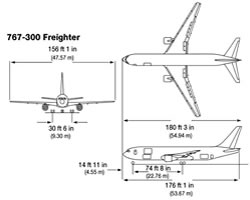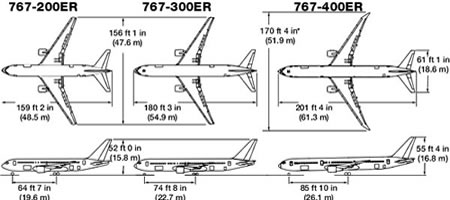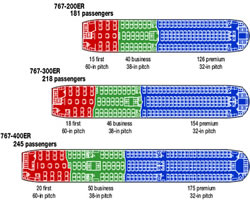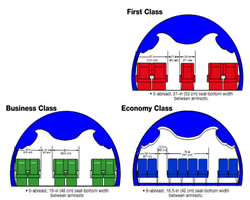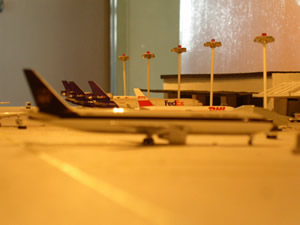|
|
||||||||||||||||||||||||||||||||||||||||||||||||||||||||||||||||||||||||||||||||||||||||||||||||||||||||||||||||||||||||||||||||||||||||||||||
|
1
|
Leading The Way In A Dynamic Market | |||||||||||||||||||||||||||||||||||||||||||||||||||||||||||||||||||||||||||||||||||||||||||||||||||||||||||||||||||||||||||||||||||||||||||||
|
|
a
|
Technical Characteristic |
||||||||||||||||||||||||||||||||||||||||||||||||||||||||||||||||||||||||||||||||||||||||||||||||||||||||||||||||||||||||||||||||||||||||||||
|
b
|
Range Capability | |||||||||||||||||||||||||||||||||||||||||||||||||||||||||||||||||||||||||||||||||||||||||||||||||||||||||||||||||||||||||||||||||||||||||||||
|
c
|
Exterior | |||||||||||||||||||||||||||||||||||||||||||||||||||||||||||||||||||||||||||||||||||||||||||||||||||||||||||||||||||||||||||||||||||||||||||||
|
d
|
Cutaway Drawing - Boeing 767-200 | |||||||||||||||||||||||||||||||||||||||||||||||||||||||||||||||||||||||||||||||||||||||||||||||||||||||||||||||||||||||||||||||||||||||||||||
|
2
|
Production Design Begins in 1981 With An Order from United Airlines | |||||||||||||||||||||||||||||||||||||||||||||||||||||||||||||||||||||||||||||||||||||||||||||||||||||||||||||||||||||||||||||||||||||||||||||
|
3
|
Continually Improved Features and Capabilities to Maintain Market Leadership | |||||||||||||||||||||||||||||||||||||||||||||||||||||||||||||||||||||||||||||||||||||||||||||||||||||||||||||||||||||||||||||||||||||||||||||
|
4
|
Preferred By Passengers, Now With A "777 Style" Interior | |||||||||||||||||||||||||||||||||||||||||||||||||||||||||||||||||||||||||||||||||||||||||||||||||||||||||||||||||||||||||||||||||||||||||||||
|
a
|
Interior | |||||||||||||||||||||||||||||||||||||||||||||||||||||||||||||||||||||||||||||||||||||||||||||||||||||||||||||||||||||||||||||||||||||||||||||
|
5
|
The Pioneer of Extended Twin-Engine Operations (ETOPS) | |||||||||||||||||||||||||||||||||||||||||||||||||||||||||||||||||||||||||||||||||||||||||||||||||||||||||||||||||||||||||||||||||||||||||||||
|
6
|
The Only 60-Ton Freighter With International Capability | |||||||||||||||||||||||||||||||||||||||||||||||||||||||||||||||||||||||||||||||||||||||||||||||||||||||||||||||||||||||||||||||||||||||||||||
|
7
|
The Boeing 767-400ER, A Versatile New Airplane For A Dynamic Market | |||||||||||||||||||||||||||||||||||||||||||||||||||||||||||||||||||||||||||||||||||||||||||||||||||||||||||||||||||||||||||||||||||||||||||||
|
8
|
Continually Improved Features and Capability To Maintain Market Leadership | |||||||||||||||||||||||||||||||||||||||||||||||||||||||||||||||||||||||||||||||||||||||||||||||||||||||||||||||||||||||||||||||||||||||||||||
|
9
|
767 Fun Facts | |||||||||||||||||||||||||||||||||||||||||||||||||||||||||||||||||||||||||||||||||||||||||||||||||||||||||||||||||||||||||||||||||||||||||||||
|
10
|
History Of The 767 Two-Crew Flight Deck | |||||||||||||||||||||||||||||||||||||||||||||||||||||||||||||||||||||||||||||||||||||||||||||||||||||||||||||||||||||||||||||||||||||||||||||
|
11
|
||||||||||||||||||||||||||||||||||||||||||||||||||||||||||||||||||||||||||||||||||||||||||||||||||||||||||||||||||||||||||||||||||||||||||||||
|
a
|
Summary | |||||||||||||||||||||||||||||||||||||||||||||||||||||||||||||||||||||||||||||||||||||||||||||||||||||||||||||||||||||||||||||||||||||||||||||
|
12
|
The Boeing 767-300 Freighter - The Newest Member Of The Boeing Freighter Family | |||||||||||||||||||||||||||||||||||||||||||||||||||||||||||||||||||||||||||||||||||||||||||||||||||||||||||||||||||||||||||||||||||||||||||||
|
13
|
Began in 1993 | |||||||||||||||||||||||||||||||||||||||||||||||||||||||||||||||||||||||||||||||||||||||||||||||||||||||||||||||||||||||||||||||||||||||||||||
|
14
|
Available Cargo Volume | |||||||||||||||||||||||||||||||||||||||||||||||||||||||||||||||||||||||||||||||||||||||||||||||||||||||||||||||||||||||||||||||||||||||||||||
|
15
|
||||||||||||||||||||||||||||||||||||||||||||||||||||||||||||||||||||||||||||||||||||||||||||||||||||||||||||||||||||||||||||||||||||||||||||||
|
16
|
The Boeing 767-400ER - A Versatile Airplane For A Dynamic Market | |||||||||||||||||||||||||||||||||||||||||||||||||||||||||||||||||||||||||||||||||||||||||||||||||||||||||||||||||||||||||||||||||||||||||||||
|
17
|
Common Features Offer Competitive Advantage | |||||||||||||||||||||||||||||||||||||||||||||||||||||||||||||||||||||||||||||||||||||||||||||||||||||||||||||||||||||||||||||||||||||||||||||
|
18
|
New Flight Deck Increases Operating Efficiency | |||||||||||||||||||||||||||||||||||||||||||||||||||||||||||||||||||||||||||||||||||||||||||||||||||||||||||||||||||||||||||||||||||||||||||||
|
19
|
Aerodynamic Wing Tip Gives More Lift Without Lengthening Wing | |||||||||||||||||||||||||||||||||||||||||||||||||||||||||||||||||||||||||||||||||||||||||||||||||||||||||||||||||||||||||||||||||||||||||||||
|
20 |
New Interiors Capture 777 Look, Feel | |||||||||||||||||||||||||||||||||||||||||||||||||||||||||||||||||||||||||||||||||||||||||||||||||||||||||||||||||||||||||||||||||||||||||||||
|
21
|
Service in 2000 | |||||||||||||||||||||||||||||||||||||||||||||||||||||||||||||||||||||||||||||||||||||||||||||||||||||||||||||||||||||||||||||||||||||||||||||
|
1
|
Leading The Way In A Dynamic Market | |||||||||||||||||||||||||||||||||||||||||||||||||||||||||||||||||||||||||||||||||||||||||||||||||||||||||||||||||||||||||||||||||||||||||||||
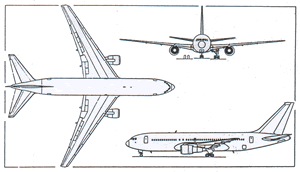 Boeing 767-200 wide-bodied airliner |
Boeing 767 family is a complete family of airplanes providing maximum market versatility in 200- to 300-seat market. Boeing 767 family includes three passenger models - 767-200ER, 767-300ER and 767-400ER - and a freighter, which is based on 767-300ER fuselage. Three passenger models differ primarily in body length, with Boeing 767-300ER approximately 21 feet (6.43 m) longer than 767-200ER, and 767-400ER approximately 21 feet (6.43 m) longer than 767-300ER. Twin-engine 767 - sized between single-aisle 757 and larger, twin-aisle 777 - has built a reputation among airlines for its profitability and comfort. |
|||||||||||||||||||||||||||||||||||||||||||||||||||||||||||||||||||||||||||||||||||||||||||||||||||||||||||||||||||||||||||||||||||||||||||||
|
|
Boeing 767's cabin is more than 4 feet (1.2 m) wider than single-aisle jetliners, and 767's versatile design allows customers to select four, five, six, seven or eight abreast seating to best suit their operational requirements. 767 seats from as few as 181 passengers in a three-class seating arrangement on 767-200ER to as many as 375 passengers in a high-density charter configuration on a 767-400ER. Extended-range airplanes typically have three-class seating of 181 to 245 passengers, using five-abreast, 747-sized first class seats; six-abreast business class and seven-abreast economy class. Lower-deck volume available for baggage and cargo ranges from 2,875 cubic feet (81.4 cu m) for 767-200 to 4,580 cubic feet (129.6 cu m) for 767-400ER. |
|||||||||||||||||||||||||||||||||||||||||||||||||||||||||||||||||||||||||||||||||||||||||||||||||||||||||||||||||||||||||||||||||||||||||||||
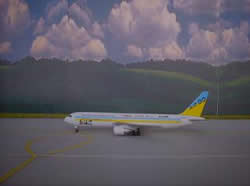 |
All three passenger models are offered in a variety takeoff weights, which allow operators to choose only the amount of design weight needed to satisfy their requirements. These offer corresponding design ranges from just over 5,645 nautical miles (10,450 km) to as many as 6,600 nautical miles (12,220 km). This range versatility gives 767 family the ability to efficiently serve routes as short as U.S. domestic and pan-European to long-range flights over North Atlantic and North Pacific. 767 now crosses Atlantic from United States to Europe more often than any other jetliner. Schedule reliability - an industry measure of departure from the gate within 15 minutes of scheduled time - is nearly 99 percent for 767. Fleet-wide, daily utilization - the actual time the airplane spends in the air - averages more than 10 hours. |
|||||||||||||||||||||||||||||||||||||||||||||||||||||||||||||||||||||||||||||||||||||||||||||||||||||||||||||||||||||||||||||||||||||||||||||
|
|
a
|
Technical Characteristic |
||||||||||||||||||||||||||||||||||||||||||||||||||||||||||||||||||||||||||||||||||||||||||||||||||||||||||||||||||||||||||||||||||||||||||||
|
|
|
767-200ER Passenger Seating Configuration | ||||||||||||||||||||||||||||||||||||||||||||||||||||||||||||||||||||||||||||||||||||||||||||||||||||||||||||||||||||||||||||||||||||||||||||
|
|
|
|
||||||||||||||||||||||||||||||||||||||||||||||||||||||||||||||||||||||||||||||||||||||||||||||||||||||||||||||||||||||||||||||||||||||||||||
|
b
|
Range Capability | |||||||||||||||||||||||||||||||||||||||||||||||||||||||||||||||||||||||||||||||||||||||||||||||||||||||||||||||||||||||||||||||||||||||||||||
| With full passenger payload from Beijing | ||||||||||||||||||||||||||||||||||||||||||||||||||||||||||||||||||||||||||||||||||||||||||||||||||||||||||||||||||||||||||||||||||||||||||||||
|
||||||||||||||||||||||||||||||||||||||||||||||||||||||||||||||||||||||||||||||||||||||||||||||||||||||||||||||||||||||||||||||||||||||||||||||
|
c
|
Exterior | |||||||||||||||||||||||||||||||||||||||||||||||||||||||||||||||||||||||||||||||||||||||||||||||||||||||||||||||||||||||||||||||||||||||||||||
|
||||||||||||||||||||||||||||||||||||||||||||||||||||||||||||||||||||||||||||||||||||||||||||||||||||||||||||||||||||||||||||||||||||||||||||||
|
d
|
Cutaway Drawing - Boeing 767-200 | |||||||||||||||||||||||||||||||||||||||||||||||||||||||||||||||||||||||||||||||||||||||||||||||||||||||||||||||||||||||||||||||||||||||||||||
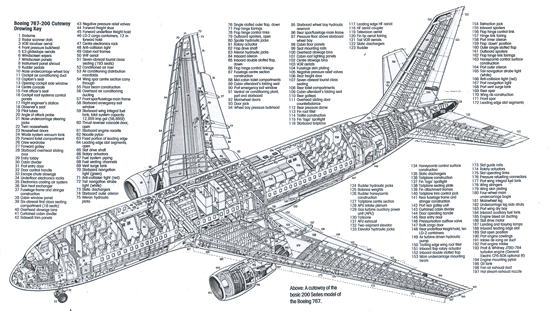 |
||||||||||||||||||||||||||||||||||||||||||||||||||||||||||||||||||||||||||||||||||||||||||||||||||||||||||||||||||||||||||||||||||||||||||||||
|
2
|
Production Design Begins in 1981 With An Order from United Airlines | |||||||||||||||||||||||||||||||||||||||||||||||||||||||||||||||||||||||||||||||||||||||||||||||||||||||||||||||||||||||||||||||||||||||||||||
|
|
Production design of 767-200 began in 1978 when an order for 30 short-to-medium-range 767s was announced by United Airlines. The first 767 - still owned by Boeing - was completed and rolled out of Boeing plant in Everett, Wash., Aug. 4, 1981. The airplane made its initial flight Sept. 26. 1981. 767-300 program got under way in September 1983. This model is longer than 767-200 by 21 feet (6.43 m); has 20 percent more seating capacity (approximately 40 passengers) and 31 percent greater cargo volume. The first 767-300 was delivered to Japan Airlines in September 1986. Each of these models was followed by an increased range (extended range or ER) version, which offers operators even more versatility. This increased range capability, and 767's uniquely low operating costs are largely responsible for the fragmentation of the North Atlantic markets. To take advantage of the airplanes' increased ranges and long, over-water flights, new features were added: an advanced propulsion system and auxiliary power unit with high-altitude start capability, a fourth hydraulic-motor-driven generator, increased cargo compartment fire-suppression capability and cooling sensors for electronic flight instruments. |
|||||||||||||||||||||||||||||||||||||||||||||||||||||||||||||||||||||||||||||||||||||||||||||||||||||||||||||||||||||||||||||||||||||||||||||
|
|
||||||||||||||||||||||||||||||||||||||||||||||||||||||||||||||||||||||||||||||||||||||||||||||||||||||||||||||||||||||||||||||||||||||||||||||
|
3
|
Continually Improved Features and Capabilities to Maintain Market Leadership | |||||||||||||||||||||||||||||||||||||||||||||||||||||||||||||||||||||||||||||||||||||||||||||||||||||||||||||||||||||||||||||||||||||||||||||
 |
767 wing is thicker, longer and less swept than the wings of earlier Boeing jetliners. This provides excellent takeoff performance and fuel economy. Each 767 is powered by two high-bypass-ratio turbofan engines, which are interchangeable with 747 engines with only minor modifications. With its advanced-design wing and powerful engines, and at a maximum gross weight of 300,000 pounds (136,080 kg), the basic 767-200, can take off on only 5,700 feet (1,735 m) of runway. It can operate nonstop between New York and San Francisco with a two-class load of 224 passengers. Even extended-range version of this airplane, 767-200ER, with a maximum takeoff weight of 395,000 pounds (179,170 kg), can take off on about 9,400 feet (2,865 m) of runway. It can fly up to 6,600 nautical miles (12,220 km), making possible such nonstop flights as New York to Beirut, Lebanon; London to Bombay, India; and Tokyo to Sydney, Australia with 181 passengers in a three-class configuration. |
|||||||||||||||||||||||||||||||||||||||||||||||||||||||||||||||||||||||||||||||||||||||||||||||||||||||||||||||||||||||||||||||||||||||||||||
|
|
||||||||||||||||||||||||||||||||||||||||||||||||||||||||||||||||||||||||||||||||||||||||||||||||||||||||||||||||||||||||||||||||||||||||||||||
|
4
|
Preferred By Passengers, Now With A "777 Style" Interior | |||||||||||||||||||||||||||||||||||||||||||||||||||||||||||||||||||||||||||||||||||||||||||||||||||||||||||||||||||||||||||||||||||||||||||||
|
FAll passenger models of 767 family offer a new, even more passenger-pleasing cabin interior. New interior, based on the award-winning design of 777, uses state-of-the-art lighting and design concepts to amplify the feeling of spaciousness on an airplane already prized for long-range comfort. For passengers, the new interior also includes new, deeper stowage bins, which means it is easier to find space in the compartments. For airlines, the new interior offers increased flexibility in positioning and maintaining lavatories. About 70 percent of the lavatory components are the same as those found on 777, easing maintenance and reducing the number and type of spare parts in airlines inventories for operators of both models. The interior also features an improved in-flight entertainment interface. 767 has earned high passenger ratings in every class of service. In economy class seating, 767 offers a seat-width that is only surpassed by Boeing 777. Independent research has shown the seven-abreast seating concept in economy is popular because it places 87 percent of the seats next to a window or aisle. 767 has the highest percentage of window seats and aisle seats of any jetliner. |
||||||||||||||||||||||||||||||||||||||||||||||||||||||||||||||||||||||||||||||||||||||||||||||||||||||||||||||||||||||||||||||||||||||||||||||
|
a
|
Interior | |||||||||||||||||||||||||||||||||||||||||||||||||||||||||||||||||||||||||||||||||||||||||||||||||||||||||||||||||||||||||||||||||||||||||||||
|
||||||||||||||||||||||||||||||||||||||||||||||||||||||||||||||||||||||||||||||||||||||||||||||||||||||||||||||||||||||||||||||||||||||||||||||
|
||||||||||||||||||||||||||||||||||||||||||||||||||||||||||||||||||||||||||||||||||||||||||||||||||||||||||||||||||||||||||||||||||||||||||||||
|
|
||||||||||||||||||||||||||||||||||||||||||||||||||||||||||||||||||||||||||||||||||||||||||||||||||||||||||||||||||||||||||||||||||||||||||||||
|
5
|
The Pioneer of Extended Twin-Engine Operations (ETOPS) | |||||||||||||||||||||||||||||||||||||||||||||||||||||||||||||||||||||||||||||||||||||||||||||||||||||||||||||||||||||||||||||||||||||||||||||
|
|
In May 1985, U.S. Federal Aviation Administration (FAA) approved 767s for long-range flights of up to 120 minutes from an alternate airport. In March 1989, FAA approved 767 as the first jetliner for 180-minute extended twin-engine operation (ETOPS). This allows more direct, time-saving trans-Pacific and trans-Atlantic flights from many U.S. gateways. After more than 15 years ETOPS has proven successful and is now part of airlines' routine operations. 767s fly more ETOPS flights than any other airplane. | |||||||||||||||||||||||||||||||||||||||||||||||||||||||||||||||||||||||||||||||||||||||||||||||||||||||||||||||||||||||||||||||||||||||||||||
|
|
||||||||||||||||||||||||||||||||||||||||||||||||||||||||||||||||||||||||||||||||||||||||||||||||||||||||||||||||||||||||||||||||||||||||||||||
|
6
|
The Only 60-Ton Freighter With International Capability | |||||||||||||||||||||||||||||||||||||||||||||||||||||||||||||||||||||||||||||||||||||||||||||||||||||||||||||||||||||||||||||||||||||||||||||
 Boeing 767-200 widebodied airliner with extra side view of proposed AWACS version (see below) |
Boeing 767 Freighter was derived from 767-300ER passenger airplane.
It was launched in January 1993, and entered service in the fourth quarter
of 1995.
The main deck of 767 Freighter can accommodate up to 24 pallets, each measuring 88 inches by 125 inches (235.5 cm by 317.5 cm) at the base. Total main deck container volume is 11,884 feet3 (336.5 m3), and two lower holds of the airplane provide 4,150 feet3 (117.5 m3) for seven pallets, two containers and bulk loading. |
|||||||||||||||||||||||||||||||||||||||||||||||||||||||||||||||||||||||||||||||||||||||||||||||||||||||||||||||||||||||||||||||||||||||||||||
|
|
These provide a combined maximum payload capability of 16,034 feet3 (429 m3). When carrying the 60.5-ton (54.88 metric tons) maximum payload, 767 Freighter has a range of 3,270 nautical miles (6,056 km). When carrying 50 tons (45.4 metric tons), 767 Freighter has a range of 4,255 nautical miles (7,880 km). The interior of main-deck fuselage has a smooth, fiberglass lining. A fixed, rigid barrier installed in the front end of main deck serves as a restraint wall between cargo and flight deck. A door in the barrier wall permits in-flight access from flight deck to cargo area. 767 Freighter keeps ton-mile costs to a minimum with its two-person flight deck and twin high-bypass-ratio engines offering excellent fuel economy. This contrasts to older cargo-carrying airplanes, such as 707s and DC-8s, which have three-person flight crews and are powered by four engines. Type commonality with 757 Freighter further reduces operating and training costs for carriers that choose to operate both models. All the advancements in avionics, aerodynamics, materials and propulsion that were developed for passenger version of 767 are incorporated in freighter. |
|||||||||||||||||||||||||||||||||||||||||||||||||||||||||||||||||||||||||||||||||||||||||||||||||||||||||||||||||||||||||||||||||||||||||||||
|
|
||||||||||||||||||||||||||||||||||||||||||||||||||||||||||||||||||||||||||||||||||||||||||||||||||||||||||||||||||||||||||||||||||||||||||||||
|
7
|
The Boeing 767-400ER, A Versatile New Airplane For A Dynamic Market | |||||||||||||||||||||||||||||||||||||||||||||||||||||||||||||||||||||||||||||||||||||||||||||||||||||||||||||||||||||||||||||||||||||||||||||
|
|
The newest member of 767 family - 767-400ER - was launched in April 1997 with an order from Delta Air Lines for 21 airplanes. This model features a fuselage that is 21 feet (6.43 m) longer than 767-300ER model, and carries approximately 15 percent more passengers. The additional seats reduce operating costs relative to 767-300ER, which already offers airlines the lowest operating costs in its class. This stretched version of 767-300ER addresses the medium-size (240- to 300-seat), intercontinental market, accommodating growth on routes that don't require the capacity of a 777. 767-400ER also replaces older airplanes serving transcontinental routes. The first 767-400ERs were delivered to Delta Air Lines and Continental Airlines in August 2000. The first 767-400ER went into service on Sept. 14, 2000. |
|||||||||||||||||||||||||||||||||||||||||||||||||||||||||||||||||||||||||||||||||||||||||||||||||||||||||||||||||||||||||||||||||||||||||||||
|
|
||||||||||||||||||||||||||||||||||||||||||||||||||||||||||||||||||||||||||||||||||||||||||||||||||||||||||||||||||||||||||||||||||||||||||||||
|
8
|
Continually Improved Features and Capability To Maintain Market Leadership | |||||||||||||||||||||||||||||||||||||||||||||||||||||||||||||||||||||||||||||||||||||||||||||||||||||||||||||||||||||||||||||||||||||||||||||
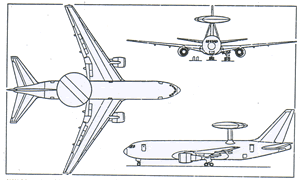 AWACS version of Boeing 767 airliner |
767 family has the lowest operating cost per trip of any widebody airplane. This low operating cost, combined with a choice of three sizes, variable range capability, almost universal airport compatibility and ETOPS capability, makes 767 a versatile family of airplanes. This versatility is an extreme competitive advantage to an operator that needs to serve a variety of different missions and passenger demands. Extensive commonality with Boeing 757, which includes a common pilot-type rating, offers even more operational versatility to 767 operators. 767 has a long history of leading the way in technological innovation. Included in its list of "firsts" are: |
|||||||||||||||||||||||||||||||||||||||||||||||||||||||||||||||||||||||||||||||||||||||||||||||||||||||||||||||||||||||||||||||||||||||||||||
|
|
|
|||||||||||||||||||||||||||||||||||||||||||||||||||||||||||||||||||||||||||||||||||||||||||||||||||||||||||||||||||||||||||||||||||||||||||||
|
|
||||||||||||||||||||||||||||||||||||||||||||||||||||||||||||||||||||||||||||||||||||||||||||||||||||||||||||||||||||||||||||||||||||||||||||||
|
9
|
767 Fun Facts | |||||||||||||||||||||||||||||||||||||||||||||||||||||||||||||||||||||||||||||||||||||||||||||||||||||||||||||||||||||||||||||||||||||||||||||
|
|
767 is the first widebody jetliner to be stretched twice. 767-300 is 21 feet (6.43 m) longer than the original 767-200; and new 767-400ER is 21 feet longer than 767-300. The first 767 entered service in Sept. 8, 1982, since then 767 have flown more than 7.5 million flights, and carried more than two billion passengers. The air flowing through a 767-400ER engine at takeoff power could inflate the Goodyear Blimp in seven seconds. It takes about 60 gallons (227 l) of fuel per passenger to get from New York to London on board a 767-400ER. Same volume of gasoline would propel an economy car about half of that distance. 767 is the favorite airplane on Atlantic routes; it flies across the Atlantic more frequently than all other jetliners combined. 767-400ER flight deck instrument panel has 82 percent fewer parts than other 767s. By using cast parts, the part count was reduced to 53 from 296. Production hours plummeted to 20 hours from 180 hours. |
|||||||||||||||||||||||||||||||||||||||||||||||||||||||||||||||||||||||||||||||||||||||||||||||||||||||||||||||||||||||||||||||||||||||||||||
|
If GE CF6-80C2B8F engines were attached to a typical automobile, at takeoff power the car would accelerate from zero to 60 mph (96.5 kph) in less than half a second. There are 3.1 million parts in a 767 provided by more than 800 international suppliers. 767 is capable of cruising at altitudes up to 43,000 feet (13,106 m) 767-300ER and 767-400ER hold 23,980 gallons (90,770 l) of fuel - enough to fill 1,200 minivans. It takes only 28 minutes to fill the airplane. Noise level of a 767 taking off from a 1.5 mile (3,000 m) runway is about the same as the average street corner traffic noise. There are 90 miles (145 km) of electrical wiring in a 767-200ER, 117 miles (188 km) in a 767-300ER and 125 miles (201 km) in a 767-400ER. |
||||||||||||||||||||||||||||||||||||||||||||||||||||||||||||||||||||||||||||||||||||||||||||||||||||||||||||||||||||||||||||||||||||||||||||||
|
|
||||||||||||||||||||||||||||||||||||||||||||||||||||||||||||||||||||||||||||||||||||||||||||||||||||||||||||||||||||||||||||||||||||||||||||||
|
10
|
History Of The 767 Two-Crew Flight Deck | |||||||||||||||||||||||||||||||||||||||||||||||||||||||||||||||||||||||||||||||||||||||||||||||||||||||||||||||||||||||||||||||||||||||||||||
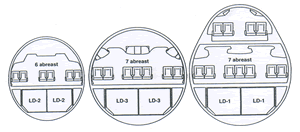 Cabin cross-sections of Boeing 767 (left), Boeing 777 (centre) and Boeing 747 show progression in size designed to afford greater scope in seating layour. Exteral diameter of Boeing 767 is 5.03 m (16 ft 6 in); Boeing 777 is 6.20 m (20 ft 4 in); and Boeing 747 is 6.49 m (21 ft 3.5 in). LD -1, -2 and -3 are international-size freight containers. boeing 747 upper deck extends only part-way along the fuselage. |
In the post-deregulation period of late 1970s, airlines were facing heavy price competition on routes that were now open to new rivals. At the same time, airplane system reliability, redundancy in system design, and exceptional record of two-crew 737 led Boeing to examine the possibility of expanding two-crew flight deck to 757 and 767 design. Airlines were interested in the two-crew aircraft for fleet expansion. Airbus was marketing its A310 and McDonnell Douglas its DC-9-80 -- both with two-pilot crews. Boeing believed that the long-term viability of 757 and 767 would require the two-person flight deck, at least as an option. Boeing wanted to give airlines a savings on weight and operating cost with two-person flight deck. Because 757 and 767 were developed at the same time, a basic design criteria was that the two airplanes be part of a "family," having common pilot type rating and sharing many parts, systems, testing and manufacturing processes. |
|||||||||||||||||||||||||||||||||||||||||||||||||||||||||||||||||||||||||||||||||||||||||||||||||||||||||||||||||||||||||||||||||||||||||||||
|
|
United Airlines was the first to order 767 (July 14, 1978). After lengthy deliberation, the airline decided that a three-person crew would reduce the introductory risk associated with being the first to put 767 into revenue service. Boeing continued to develop a second, two-crew version as an option for later customers. Contracts with major suppliers for two-crew flight deck were being established as early as October 1978. By the end of that year, three different flight-deck configurations were being planned. "Hard-wired," or permanent, three-crew was to be introduced in August 1982 on the first 767 delivered to United. 767 also would be available with a two-crew convertible option, meaning this design could be easily modified into a three-crew configuration. A third option, the three-crew convertible, was ready by February 1983. In this case, the design could be modified later to a two-crew configuration. Boeing launched 757 program in April 1979, and the first airplane was scheduled to roll out with the two-crew flight deck in January 1983. A three-crew convertible was to be ready for 757 by April 1983. The crew-size debate reached its peak in the spring of 1981, when a U.S. presidential task force was commissioned to determine the safety of two-crew operations for large widebody aircraft. After several months of hearings and extensive human-factors and safety data analyses, task force concluded in July 1981 that two-crew operations could be conducted safely. This decision came less than a month before the first 767 was to roll out of factory. Following the task force report, United Airlines pilots' union agreed to fly a two-crew 767. With similar agreements among other airlines and their pilots, the last major barrier to full acceptance of two-pilot configuration was removed. Eleven of the 12 airlines that had ordered three-crew 767s changed their orders to two-crew design. Timing of a change of this magnitude had enormous implications for 767 production and certification. Extensive planning and lead time were needed. The first structural parts went into production two years before the airplane was to roll out of factory in August 1981. The first avionics system (an inertial navigation gyro) was delivered 20 months before rollout. By September 1981, Boeing had developed the necessary plans to retrofit airplanes already produced with three-crew flight deck and to incorporate the new design into the production line, beginning with 31st airplane. U.S. Federal Aviation Administration (FAA) certification proceeded on the first six airplanes produced. A seventh test airplane was added to certification flight-test program after it had been retrofitted with new digital flight deck. It took its first flight May 27, 1982 -- just three months after 757 first flight. Boeing used airplanes configured for three crew members to conduct certification tests that did not depend on flight deck configuration. Crew size, workload and operational proof testing was conducted using retrofitted two-crew test airplane. To avoid slowing or interrupting FAA certification process, Boeing chose to build the first 30 airplanes as fully functional (and certifiable) airplanes under the expected FAA certification for three-crew model. This decision was based on company's ability to better control one of only two possible airplane configurations, rather than many configurations that would have resulted if changes were incorporated on different airplanes at different stages of production. Among the impacts of offering a two-crew flight deck were the cost of modifying 30 airplanes; the cost of original design and installation of three-person flight decks; and the delay of delivery schedule (Boeing delivered 20 767s in 1982, eight fewer than planned). FAA certification was awarded July 30, 1982, and United took first delivery August 19, 1982. |
|||||||||||||||||||||||||||||||||||||||||||||||||||||||||||||||||||||||||||||||||||||||||||||||||||||||||||||||||||||||||||||||||||||||||||||
|
|
||||||||||||||||||||||||||||||||||||||||||||||||||||||||||||||||||||||||||||||||||||||||||||||||||||||||||||||||||||||||||||||||||||||||||||||
|
11
|
||||||||||||||||||||||||||||||||||||||||||||||||||||||||||||||||||||||||||||||||||||||||||||||||||||||||||||||||||||||||||||||||||||||||||||||
|
|
|
|||||||||||||||||||||||||||||||||||||||||||||||||||||||||||||||||||||||||||||||||||||||||||||||||||||||||||||||||||||||||||||||||||||||||||||
|
|
||||||||||||||||||||||||||||||||||||||||||||||||||||||||||||||||||||||||||||||||||||||||||||||||||||||||||||||||||||||||||||||||||||||||||||||
|
a
|
Summary | |||||||||||||||||||||||||||||||||||||||||||||||||||||||||||||||||||||||||||||||||||||||||||||||||||||||||||||||||||||||||||||||||||||||||||||
|
||||||||||||||||||||||||||||||||||||||||||||||||||||||||||||||||||||||||||||||||||||||||||||||||||||||||||||||||||||||||||||||||||||||||||||||
|
|
||||||||||||||||||||||||||||||||||||||||||||||||||||||||||||||||||||||||||||||||||||||||||||||||||||||||||||||||||||||||||||||||||||||||||||||
|
12
|
The Boeing 767-300 Freighter - The Newest Member Of The Boeing Freighter Family | |||||||||||||||||||||||||||||||||||||||||||||||||||||||||||||||||||||||||||||||||||||||||||||||||||||||||||||||||||||||||||||||||||||||||||||
|
|
767-300 Freighter is the newest member of Boeing family of freighters, joining 747-400 Freighter and 757-200 Freighter. 767 Freighter is a derivative popular 767-300ER (extended range) passenger twinjet. All the advancements in avionics, aerodynamics, materials and propulsion that were developed for passenger versions of 767 are incorporated in freighter. Its design provides excellent fuel efficiency, operational flexibility, low-noise levels and an all-digital flight deck. The structure employs aluminum alloys and composite materials. 767 Freighter is similar in external appearance to 767 passenger airplanes, except for the lack of passenger windows and doors. Interior of main-deck fuselage has a smooth fiberglass lining. A fixed, rigid barrier installed in front end of main deck serves as a restraint wall between cargo and flight deck. A door in the barrier wall permits in-flight access from flight deck to cargo area. The freighter model also benefits from 767's established schedule or "dispatch" reliability, performance and operational advantages. Schedule reliability - an industry measure of departure from gate within 15 minutes of scheduled time - is nearly 99 percent for 767. Fleetwide, daily utilization is more than 10 hours. 767 Freighter keeps ton-mile costs to a minimum with its two-person flight deck, and its twin high-bypass-ratio engines offer excellent fuel economy. The cargo airplane's operating costs, per available ton-mile, are projected to be 20 percent lower than those of its closest competitors. This contrasts with older cargo-carrying aircraft, such as 707s and DC-8s, that have three-person flight crews and are powered by four engines. 767 Freighter also has a common-type rating with 757 Freighter, providing airlines with flexibility in scheduling flight crews. More than 40 airlines have combined 767 and 757 fleets. Boeing has been the world leader in civilian air cargo since 707 Freighter was introduced more than 30 years ago. As of 2000 three airlines have purchased 36 767-300 Freighters. |
|||||||||||||||||||||||||||||||||||||||||||||||||||||||||||||||||||||||||||||||||||||||||||||||||||||||||||||||||||||||||||||||||||||||||||||
|
|
||||||||||||||||||||||||||||||||||||||||||||||||||||||||||||||||||||||||||||||||||||||||||||||||||||||||||||||||||||||||||||||||||||||||||||||
|
13
|
Began in 1993 | |||||||||||||||||||||||||||||||||||||||||||||||||||||||||||||||||||||||||||||||||||||||||||||||||||||||||||||||||||||||||||||||||||||||||||||
|
|
Boeing launched 767 Freighter in January 1993, when Atlanta-based
United Parcel Service (UPS) announced an order for up to 60 freighters.
Purchase was the largest order for all-cargo aircraft ever received by
Boeing.
The first UPS freighter entered production in January 1995, at Boeing factory in Everett, Wash. It rolled out in May 1995, and entered flight testing in June 1995. It was delivered to UPS in October 1995. |
|||||||||||||||||||||||||||||||||||||||||||||||||||||||||||||||||||||||||||||||||||||||||||||||||||||||||||||||||||||||||||||||||||||||||||||
|
|
||||||||||||||||||||||||||||||||||||||||||||||||||||||||||||||||||||||||||||||||||||||||||||||||||||||||||||||||||||||||||||||||||||||||||||||
|
14
|
Available Cargo Volume | |||||||||||||||||||||||||||||||||||||||||||||||||||||||||||||||||||||||||||||||||||||||||||||||||||||||||||||||||||||||||||||||||||||||||||||
|
|
With more than 16,034 feet3 (454 m3) of cargo volume available, and
ability to carry approximately 60.5 tons (54.88 tonnes) of revenue payload
more than 3,270 nautical miles (6,056 km), this airplane is an ideal freighter
to meet medium-size requirements and to replace aging 707 and DC-8 Freighters.
Up to 24 pallets, each measuring 88 inches by 125 inches (235.5 cm by 317.5 cm) at base, can be accommodated on the main deck. Total main-deck container volume is 11,884 feet3 (336.5 m3), and two lower holds of the airplane provide 4,150 feet3 (117.5 m3) for seven pallets, two containers and bulk loading. Freighter's main-deck cargo system offers flexibility of accepting virtually all types of pallets and containers in air-cargo industry. 767 Freighter is well-suited to directly accommodate transfer of pallets and containers commonly used in existing widebody freighters, such as 747-200, 747-400 and DC-10, as well as those from single-aisle freighters, including 757-200. This allows an operator to "interline" freight from one airplane to another until it reaches its destination. 767 Freighter features a large cargo door on main deck of the forward fuselage, a single crew-entry door and a freighter interior. |
|||||||||||||||||||||||||||||||||||||||||||||||||||||||||||||||||||||||||||||||||||||||||||||||||||||||||||||||||||||||||||||||||||||||||||||
|
|
||||||||||||||||||||||||||||||||||||||||||||||||||||||||||||||||||||||||||||||||||||||||||||||||||||||||||||||||||||||||||||||||||||||||||||||
|
15
|
||||||||||||||||||||||||||||||||||||||||||||||||||||||||||||||||||||||||||||||||||||||||||||||||||||||||||||||||||||||||||||||||||||||||||||||
|
|
767 Freighter is equipped with powered cargo-handling equipment, both main deck and in lower holds. Cargo-handling system provides complete automation cargo-loading process, with operator's interface through control panels and joysticks. Freighter's main deck has both interior and exterior master control panels as well as local control panels to provide maximum flexibility. Cargo-handling system's power-drive units move cargo containers into and out of the airplane and are equipped with high-tech sensors. Sensor information is fed back to system's microprocessor-based controllers, which move only power-drive units necessary to load each container, preventing wear and tear on equipment and improving reliability. Another advantage is that the power-drive units weigh less than those used on previous airplanes. A unique feature cargo-handling system is the extensive use of built-in test equipment, or BITE, which allows troubleshooting in event of a system problem. This function not only detects and isolates controller faults, it also provides maintenance operator with a series of automated tests to isolate other system faults. Environmental control system changes make the airplane suitable for transporting live animals and perishable goods. Plenty of fresh air is delivered to cargo areas, and temperatures can be controlled to cool or heat freight appropriately. |
|||||||||||||||||||||||||||||||||||||||||||||||||||||||||||||||||||||||||||||||||||||||||||||||||||||||||||||||||||||||||||||||||||||||||||||
|
|
||||||||||||||||||||||||||||||||||||||||||||||||||||||||||||||||||||||||||||||||||||||||||||||||||||||||||||||||||||||||||||||||||||||||||||||
|
16 |
The Boeing 767-400ER - A Versatile Airplane For A Dynamic Market | |||||||||||||||||||||||||||||||||||||||||||||||||||||||||||||||||||||||||||||||||||||||||||||||||||||||||||||||||||||||||||||||||||||||||||||
|
|
Boeing 767-400ER (extended range) airplane is the newest derivative of Boeing 767 family. Sized between Boeing 767-300ER and Boeing 777-200, 767-400ER features a lengthened fuselage; aerodynamic improvements, including additional wing span; increased takeoff weight capability; and an all-new main landing gear. New 767-400ER brings significant improvements in operating economics over competing airplanes in 240- to 300-seat market. Payload capability, intercontinental range, passenger comfort and commonality with other Boeing jetliners give this airplane strong market appeal. 767-400ER fuselage adds 21 feet (6.4 m) to baseline 767-300 airframe. 767-400ER provides approximately 15 percent more seats - accommodating 245 passengers in a three-class configuration and 304 passengers in a two-class configuration - compared with 229 and 255, respectively, in 767-300 version. Added seats will reduce operating costs relative to 767-300ER, which already offers airlines the lowest operating costs in its class. 767-400ER is designed to be the most efficient airplane in its size category, making it an ideal replacement for aging L-1011, DC-10-30 and A300 airplanes. In growing markets, it can fly more passengers on routes served by existing 767s, A300-600s and A310s. Efficient design gives the higher-capacity 767-400ER excellent range capability (approximately 5,645 nautical miles or 10,450 km) to fly about 99 percent of the routes currently being served by airplanes in this size category. In comparison with Airbus A330-200, 767-400ER offers superior economic performance - with at least 4 percent lower operating costs. 767-400ER weighs 40,000 pounds less than A330-200. 767-400ER can fly all U.S. domestic routes. It also will serve North Atlantic routes such as Los Angeles-London, Newark-Moscow or Chicago-Warsaw. Other potential routes include New York-Santiago, Chile; Seattle-Osaka and Atlanta-Honolulu. |
|||||||||||||||||||||||||||||||||||||||||||||||||||||||||||||||||||||||||||||||||||||||||||||||||||||||||||||||||||||||||||||||||||||||||||||
|
|
||||||||||||||||||||||||||||||||||||||||||||||||||||||||||||||||||||||||||||||||||||||||||||||||||||||||||||||||||||||||||||||||||||||||||||||
|
17
|
Common Features Offer Competitive Advantage | |||||||||||||||||||||||||||||||||||||||||||||||||||||||||||||||||||||||||||||||||||||||||||||||||||||||||||||||||||||||||||||||||||||||||||||
|
|
767-400ER brings all competitive advantages of airplane family commonality to an operator's fleet. This derivative shares common features with 757/767 family of airplanes, including a common pilot type rating between 757 and 767. This allows any pilot trained to fly one model to be qualified to fly other model with minimal additional instruction. Compatibility with 757/767 family means that operators can gain better access to demanding, medium-size market (200-300 seats) by matching appropriate airplane to variable requirements. They can also improve operating efficiency through lower training requirements, greater flexibility in assigning flight crews, and reduced spares inventories. Commonality also ensures that 767-400ER is an easy addition to existing 767 fleets and will have low impact on existing 757 fleets. |
|||||||||||||||||||||||||||||||||||||||||||||||||||||||||||||||||||||||||||||||||||||||||||||||||||||||||||||||||||||||||||||||||||||||||||||
|
|
||||||||||||||||||||||||||||||||||||||||||||||||||||||||||||||||||||||||||||||||||||||||||||||||||||||||||||||||||||||||||||||||||||||||||||||
|
18
|
New Flight Deck Increases Operating Efficiency | |||||||||||||||||||||||||||||||||||||||||||||||||||||||||||||||||||||||||||||||||||||||||||||||||||||||||||||||||||||||||||||||||||||||||||||
|
|
New flight deck makes the airplane easier to maintain and provides flexibility for operators to tailor flight-deck equipment to their training needs. A new instrument panel and avionics package consolidate 67 different flight deck parts to 20, simplifying maintenance and improving flight crew efficiency. Instrument panel, the most notable change is use of six large liquid-crystal displays in the same arrangement as 777 and Next-Generation 737 flight decks. Pilots of these models receive similar information in a similar format. This significantly reduces training requirements to transition pilots of these other Boeing models to 767-400ER. Avionics package contains an all-new display system and upgraded navigation equipment. These improvements mean operators will be able to add enhanced operational capabilities, including future air navigation system requirements. 767-400ER maintains the same pilot-type rating with 767 fleet and a common pilot-type rating with 757s for continued airline flexibility in training and scheduling flight crews. |
|||||||||||||||||||||||||||||||||||||||||||||||||||||||||||||||||||||||||||||||||||||||||||||||||||||||||||||||||||||||||||||||||||||||||||||
|
|
||||||||||||||||||||||||||||||||||||||||||||||||||||||||||||||||||||||||||||||||||||||||||||||||||||||||||||||||||||||||||||||||||||||||||||||
|
19
|
Aerodynamic Wing Tip Gives More Lift Without Lengthening Wing | |||||||||||||||||||||||||||||||||||||||||||||||||||||||||||||||||||||||||||||||||||||||||||||||||||||||||||||||||||||||||||||||||||||||||||||
|
|
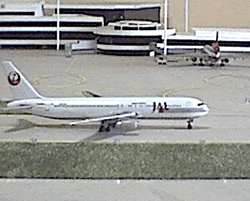 |
767-400ER features new, highly back-swept (raked) wing-tip extensions that increase 767's 156-foot wingspan to 170 feet, 4 inches (51.9 m). 7-foot-8-inch (2.4 m) wing extensions are designed to increase aerodynamic efficiency wing. Another advantage of the raked wing-tip design is its simplicity. It is lightweight and bolts into place, with no additional design changes needed to tip or leading edges of 767-300 wing. This efficiency of design and economy of structure affords 767-400ER more gate and taxiway flexibility. It can use same gates as DC-10-30, MD-11 and L-1011, unlike A330-200, which must use gates sized by industry for large airplanes such as 747 and 777. Raked wing tip balances cruise efficiency and airplane weight to achieve improved range. | ||||||||||||||||||||||||||||||||||||||||||||||||||||||||||||||||||||||||||||||||||||||||||||||||||||||||||||||||||||||||||||||||||||||||||||
|
|
||||||||||||||||||||||||||||||||||||||||||||||||||||||||||||||||||||||||||||||||||||||||||||||||||||||||||||||||||||||||||||||||||||||||||||||
|
20 |
New Interiors Capture 777 Look, Feel | |||||||||||||||||||||||||||||||||||||||||||||||||||||||||||||||||||||||||||||||||||||||||||||||||||||||||||||||||||||||||||||||||||||||||||||
|
|
767-400ER interiors have adopted architectural lines of award-winning 777 interior. Newly sculpted sidewalls, ceilings and stow bins enhance the wide, open feeling that passengers already prefer. Also, larger, pivoting, overhead stow bins provide generous stowage volume for passenger use. 767-400ER will retain interior features of 767 that have earned high passenger ratings in every class of service. For example, independent research has shown seven-abreast seating concept is popular because it places 86 percent of seats next to a window or aisle. Unlike its closest competitor, first-class seating on 767-400ER uses the international standard 21-inch (53.3 centimeter) seat bottom-width. In economy class seating, 767 offers a seat-width that is only surpassed by Boeing 777. For all classes of seating, airplane sidewalls are shaped for clearance around head and shoulders for greater passenger comfort. |
|||||||||||||||||||||||||||||||||||||||||||||||||||||||||||||||||||||||||||||||||||||||||||||||||||||||||||||||||||||||||||||||||||||||||||||
|
|
||||||||||||||||||||||||||||||||||||||||||||||||||||||||||||||||||||||||||||||||||||||||||||||||||||||||||||||||||||||||||||||||||||||||||||||
|
21
|
Service in 2000 | |||||||||||||||||||||||||||||||||||||||||||||||||||||||||||||||||||||||||||||||||||||||||||||||||||||||||||||||||||||||||||||||||||||||||||||
|
|
767-400ER was launched April 28, 1997, when Atlanta-based Delta Air
Lines announced its intent to order 21 airplanes. Continental Airlines
ordered 26 airplanes on Oct. 10, 1997. The first airplane rolled out of
Boeing factory August 26, 1999 and made its inaugural flight October 9, 1999. Delivery of the first 767-400ERs were delivered to Delta Air Lines and Continental Airlines in August 2000. The first 767-400ER went into service on September 14, 2000. |
|||||||||||||||||||||||||||||||||||||||||||||||||||||||||||||||||||||||||||||||||||||||||||||||||||||||||||||||||||||||||||||||||||||||||||||
| All images are taken by CCKing | ||||||||||||||||||||||||||||||||||||||||||||||||||||||||||||||||||||||||||||||||||||||||||||||||||||||||||||||||||||||||||||||||||||||||||||||
|
|
||||||||||||||||||||||||||||||||||||||||||||||||||||||||||||||||||||||||||||||||||||||||||||||||||||||||||||||||||||||||||||||||||||||||||||||

